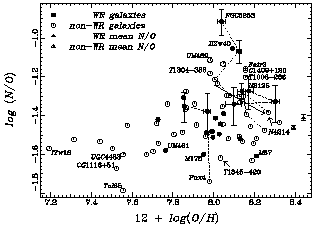


4.3.2. N/O
Figure 11 shows the N/O abundances versus O/H for a sample of dIs and HII galaxies compiled by Kobulnicky & Skillman (1996). While the production of O in galaxies is dominated by nucleosynthesis in massive stars and relatively prompt return to the ISM via supernovae explosions, the dominant processes leading to the enrichment of N in galaxies is still not well understood. It seems clear that the secondary production of N from C and O in the CNO cycle in intermediate mass stars, with subsequent release into the ISM via red giant winds and planetary nebula, must play an important role. In the more massive spiral galaxies, at higher metallicities, N/O increases roughly linearly with O/H, as would be expected if this secondary production mechanism dominated N production (Vila-Costas & Edmunds 1993).

|
Figure 11. Log(N/O) versus 12 + log(O/H) for 72 measurements of 60 low-metallicity galaxies from the literature. Abundances have been recomputed in a self-consistent manner from published line strengths. Triangles mark the average values of log(N/O) for galaxies with and without WR features when NGC 5253 is removed from the sample. The difference between the two subsamples becomes negligible if galaxies with 12 + log(O/H) < 7.6 are excluded from the sample. A heavy vector shows the theoretical evolution of metal-poor galaxies during a period of oxygen pollution (Garnett 1990, Fig. 7). (From Kobulnicky & Skillman 1996). |
In contrast, it has been known for some time that N/O is relatively constant over a large range in metallicity in the stars in our galaxy (Laird 1985; Carbon et al. 1987) and that the dwarf irregular galaxies also show relatively constant N/O (although with large scatter; Garnett 1990, Thuan et al. 1995). A constant value of N/O over a large range in metallicity could be taken as evidence of primary production of N (Pagel 1985).
Two processes leading to primary N production have been suggested. Renzini & Voli (1981) showed that increasing the convective scale length over the pressure scale length resulted in freshly synthesized 12C being brought up to the convective envelope whereupon it can by converted to N via the CNO cycle. This "hot bottom burning" mechanism (Iben & Renzini 1983) will be most effective in the mass range of 4 to 5 solar masses. Alternatively, Timmes, Woosley, & Weaver (1995) and Woosley & Weaver (1995) have suggested that primary N might be produced in massive stars (heavier than 30 solar masses) of low metallicity. Again, if convection is enlarged beyond the standard models, a convective, helium burning shell penetrates into the hydrogen burning shell, and freshly synthesized C is converted into N.
These two primary N production processes would have substantially different delivery times. The primary N produced in hot bottom burning in intermediate mass stars would be returned to the ISM only after a few hundred million years. The primary N produced in the low metallicity, high mass stars would be returned in less than 10 million years. Note that the secondary N produced in intermediate mass stars would have the same delayed delivery as the primary N produced in intermediate mass stars.
Garnett (1990) discussed the possibility that the spread in the values of N/O at a given O/H as measured in dwarf irregulars could be attributed to a delay between the delivery of O and N to the ISM (as proposed by Edmunds & Pagel 1978). If a dwarf galaxy experiences a dominant global burst of star formation, then the ISM O abundance will increase after roughly 10 million years, with a resulting decrease in N/O (as perhaps in the case of NGC 6822; Skillman, Terlevich, & Melnick 1989). Then, over the period of several hundred million years, the N/O abundance ratio will increase at constant O/H (given the absence of a subsequent burst of star formation in that time interval, as perhaps in the case of the Pegasus dwarf irregular galaxy; Skillman, Bomans, & Kobulnicky 1997, see Section 6.2). Under these two assumptions (dominant bursts of star formation separated by quiescent periods and delayed N delivery to the ISM) the N/O ratio becomes a clock, measuring the time since the last major burst of star formation. Low values of N/O imply a very recent burst of star formation, while high values of N/O imply a long quiescent period.